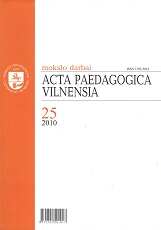GIMNAZIJŲ INSTITUCINIO VIRSMO PROJEKTAVIMO PROCESAS: VEIKSNIAI IR TENDENCIJOS
THE PROCESS OF INSTITUTIONAL TRANSFORMATION OF GYMNASIUMS: FACTORS AND TRENDS
Author(s): Rita DukynaitėSubject(s): Education
Published by: Vilniaus Universiteto Leidykla
Keywords: gimnazija1; gimnazijų institucinis virsmas2; gimnazijų projektavimo proceso veiksniai3; tendencijos4;
Summary/Abstract: The article presents the results of the study of the design process for the transformation of general edu¬cation schools into gymnasiums and an analysis of scientific insights and documents connected with the process of change in the organisation purpose and of the views of education experts, teachers, and pupils. Based on numerous documented materials and the assessments provided by the process participants, an attempt is made to identify the factors and trends of the gymnasium design process covering a period of almost twenty years. The official gymnasium ideology and the proc¬ess of designing their institutional transformation have passed from the special attention to individual groups of children (talented and motivated children) towards general values and high-quality differenti¬ated education for everyone, and from institutional diversity towards unification. Three trends were identified in the gymnasium transformation design process: initiation of gymnasiums as colleges; devel¬opment of gymnasiums as institutions for educating talented pupils; and gymnasiums as the final stage of general education for everyone. The gymnasium de¬sign process and the institutional transformation of gymnasiums into a different type of school in Lithua¬nia or the possible models have not been scientifical¬ ly substantiated and described in full, and have not been discussed or explained to education organisers, education specialists and practitioners of all levels. However, gymnasium related documents were pre¬pared, adopted and reviewed. Attempts to find a suit¬able institutional model have been undertaken. Some of the models identified have been tested. It should be emphasised that, due to the situa¬tion that developed, globalisation, and the impact of rapid change, gymnasia were and to a certain extent continue to remain doomed in the search for a design model, and more than just one institutional transfor¬mation and change in purpose may lie ahead. Key words: gymnasium, institutional transfor¬mation of gymnasia, gymnasium design process factors, trends.
Journal: Acta Paedagogica Vilnensia
- Issue Year: 2010
- Issue No: 25
- Page Range: 137-149
- Page Count: 13
- Language: Lithuanian

